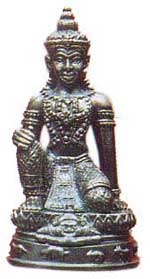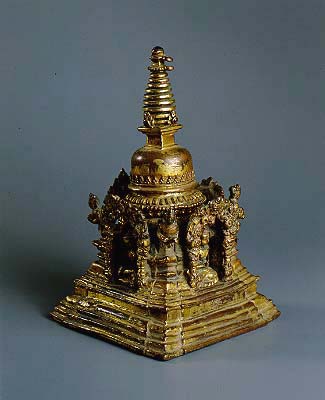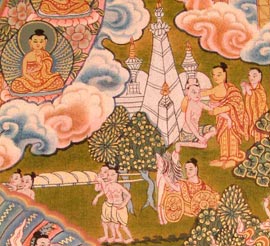
Once upon a time, many centuries ago (about 1700 years ago), it was a time of war and trouble. There lived a king and his princes in Central Siam. The elder prince named
Jatukam and the other named
Ramathep. After many years of war, the King finally conquered and managed to secure
Sri Lanka into part of his Kingdom. There was a saying that the King possessed a sacred treasure, this was none other than the holy relics of Lord Buddha. Before the King began his journey to the newly conquered land, he tasked the protection of the relics to his two princes, & ordered them to guard it with their lives.
Some time later, the princes received information of plan by their enemies to capture the relics. They immediately informed the King in
Sri Lanka. The King instruction was to quickly take the relics away by sea and head to
Sri Lanka. Halfway through the journey, a thunderstorm struck and their ships were sunken. Except the two princes, the rest of the crew did not survive.
The two princes were washed ashore, but well. Without the sea transport, they could no longer bring the relics to
Sri Lanka. They started praying sincerely to the relics, saying:
“Dear Enlightened One! If this land we step upon is a holy piece of land, then please guide us let us live a new life here. With our people, we shall guard and protected your relics forever.”Later the two princes built a temple on this holy land and with much
hard work, they also establish a wealthy and strong city. They brought new hope and peace to all the people. In remembrance of the great deeds by the two princes, they named this place
Nakhon Si
Thammarat in their honour. This is now located in Southern Thailand at the present time. The temple that the two princes built for the relics is called Wat
Mahathat - as it is known now.
Ever since then, after a few centuries, many people had travelled to Wat
Mahathat to locate the relics that were buried by the princes. Finally, they found a stone carving and the relics buried at the Wat. The stories of the two princes were found engraved on this stone.
The two princes had done many great deeds and the greatest is by erecting the temple to house the relics. And they promised to guard the Relics with their lives. They had earned respect from both the heavenly and earthly beings. Later, the people combined the two princes into one and named him Tao
Jatukam Ramathep when praying to him. Tao
Jatukam Ramathep becomes one of the most respected and popular deities in the South of Thailand. In olden days, Tao was used to address noble ones. It is believed that those that pray to Tao
Jatukam Ramathep will be blessed with fulfilling life and better in all aspects in everyday work. (End)

Wat
Phra MahathatThe temple is located on
Ratchadamnoen Road in
Tambon Nai Muang,
Amphue Meuang of
Nakhon Si
Thammarat province. This is one of the most important historical sites in Southern Thailand. The
stupa, 55.78m high, has a distinctive
Sri Lankan style. The top of the spire is entirely covered in pure gold. Inside the temple are many buildings of importance, especially the royal building which has beautiful architecture from the
Ayutthaya period and the Sam
Chom building, where the Buddha image garbed in royal attire -
Phra Si
Thamma Sokarat is housed. There are also the
Phra Maha Phinetkrom (the equestrian image) building and the
Thap Kaset building; while the
Khian and
Pho Lanka buildings are used to display artifacts donated to the temple by Buddhists from the whole region.

Over the doorway at the entrance of Wat
Phra Mahathat in
Nakhon Si
Thammarat, there are the statutes of Tao
Kadtukam and Tao
Ramathep, the guardian deities of holy relics of the Buddha. The name of one deity is Tao
Kadtukam, which later people understand that he is none other than
Jatukam.
There are many stories on how the City Pillar (Lak Meuang) and the first Jatukam amulets were made. One story tells of Police Maj Gen Sanpetch Thammikun, the provincial police chief during the 1980s, going to Wat Nang Phraya during a shamanistic ritual. The medium, a woman, told the policeman to come back. When he did come back later the woman wasn't there, but had been replaced by a new medium claiming to be the spirit of the military leader for the B.E. 17th century Nakhon Si Thammarat king.

The police general came a third time, and the second medium claimed to be yet another spirit -
Jatukam, who instructed him to lead the construction of a city pillar. However, the spirit advised him that first he should consult with Police Maj Gen
Khun Pantarakrachadej (also known as
Ajarn Khun Phan), who was thought to be a master of Buddhist magical arts (Puttakom). This is believed by some to be the reason why
Jatukam Ramathep was chosen to be a model for the amulet images when the campaign to raise funds for the city pillar was launched. The city pillar was partly completed in 1986, and the original
Jatukam amulets were made in 1987. It was circular pendant a five-centimetres in diameter, and was priced at 49 baht. Now many are sold for more than 100,000 baht each. In the past only very few
Jatukam amulets were produced, but after Police Maj Gen
Khun Pantarakrachadej (
Khun Phan) passed away recently at the age of 103 (some say 108), the amulets again became very popular. It may be significant that his death on Sep 5
th 2006 was just two weeks before the military coup in Bangkok. Since the royal cremation ceremony of
Khun Phan last February,
Jatukam amulets have become even more popular. But how long can the craze last?
 The Dhammapada says:
The Dhammapada says:
 Wat
Wat  Over the doorway at the entrance of Wat
Over the doorway at the entrance of Wat  The police general came a third time, and the second medium claimed to be yet another spirit -
The police general came a third time, and the second medium claimed to be yet another spirit - 

 If you contemplate on these changes, you will gain the insight that good & bad, happiness & suffering is all in the mind. It has nothing to do with birth, aging, sickness & death - these are only natural processes for the physical body, which is by nature illusionary. To give an example, for those old folks whose minds are happy & contented, old age is a time of relaxing & enjoying life. But for those who are bitter & dissatisfied, it becomes a time of anxiety & regret.
If you contemplate on these changes, you will gain the insight that good & bad, happiness & suffering is all in the mind. It has nothing to do with birth, aging, sickness & death - these are only natural processes for the physical body, which is by nature illusionary. To give an example, for those old folks whose minds are happy & contented, old age is a time of relaxing & enjoying life. But for those who are bitter & dissatisfied, it becomes a time of anxiety & regret.